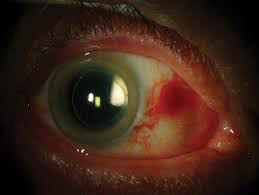Good evening to all, hope you all had a splendidly day I hereby present to you another edition of my diary session. I woke up very late at. 6am which is so abnormal for me reason being I was so tired then I quickly took my bath and brushed up. Later on I got dressed and made something to eat
 .
.
Thereafter I went out for classes at 7:20am and I came back home at 10am. While at home, I carried read about Understanding The Different Types Of Cataract.
Cataracts are a clouding of the lens in the eye. It is the result of the normal aging process and comes from a build-up of protein on the eyes lens.The onset of cataracts is slow and may not perceptible at first. The good news is that cataracts can be detected as part of a routine eye exam. The even better news is that surgery can correct your vision and get you back to seeing all of the things you love.
Symptoms of cataracts will vary based on the type of cataract you develop.Overall, if you have or are developing a cataract you will notice a change in vision.
Here are some other common symptoms:
1:Blurred vision
2:Double vision
3:Seeing halos
4:Changes in night vision and depth perception
5:Sensitivity to sunline causing your vision to decrease
6:Difficulty distinguishing colors
7:Difficulty reading
8:There are three primary types of cataracts: nuclear sclerotic, cortical, and posterior subcapsular they also have unique symptoms which are discussed below.
Nuclear Sclerotic Cataracts
This is the most common form of cataract. It begins at the nucleus of the eye (the central zone). Nuclear Sclerotic Cataract progresses slowly, often developing over the years.It begins with a gradual hardening and yellowing of the nucleus of the eye that spreads to other layers of the eye as it progresses.
An interesting fact about this type of cataracts is as it progresses it creates Second Sight. Second Sight creates a temporary improvement in close-up (near-sight) vision. However this vision improvement is not permanent, as Nuclear Sclerotic Cataract progresses, your vision will become worse.
Cortical Cataracts;
If you have diabetes, you are at higher risk of developing this type of cataracts.Cortical Cataracts start the reverse of the Nuclear Sclerotic Cataracts. It starts from the outer most layer of the eye. As it progresses it creates spokes that lead from the outside of the lens to the nucleus.
The symptoms of this cataract are blurred vision, difficulty with glare, and changes in both contrast and depth perception.
Posterior Subcapsular Cataracts
If you have diabetes or extreme nearsightedness you are at increased risk of this type of cataracts. Individuals who use steroids, either recreationally or as part of medical treatment, are also at higher risk.
With posterior subcapsular cataracts, you will first notice changes in your night vision. You may also notice more difficulty reading with this cataract.
This cataract develops quickly, typically over months not years.
NB; If you think you have cataracts, see an eye doctor for an exam to find out for sure.
How Cataracts Develop: Understanding How the Eye Functions
It is generally accepted that cataracts are a normal part of the aging process. There are however other risk factors associated with an increase of developing cataracts.
These risk factors fall into 3 categories: Behaviors you can change to lower your risk, medication use, and factors outside of your control.
Behaviors that Can Be Changed to Reduce Your Risk of Cataract
Ultraviolet radiation from the sun
Diabetes
Hypertension
Obesity
Smoking
Significant alcohol consumption
Risks Associated with Medication Use
Prolonged use of corticosteroid medications
Statin medicines used to reduce cholesterol
Previous eye injury or inflammation
Previous eye surgery
Hormone replacement therapy
Non-Modifiable Risks
Family history
Previous eye injury or inflammation
Previous eye surgery
High myopia (nearsightedness)
The general theory is that a protein build up as a result of oxidative changes in the lens cause the development of cataracts.
How Your Eyes Work
A camera and your eye both work the same way.
The eye and a camera lens focus light. In the eye, this light hits the retina. The retina also adjusts the focus of your eyes. The retina then converts what you see to neurological impulses and transfers them to the optic nerve. This process creates your vision.
The lens of your eye consists of protein and water. The structural relationship between the protein and water lets in light and allows you to see.
As we age, the proteins aggregate and shift locations causing cloudy vision and cataracts.
Cataract Prevention
There are several ways to reduce your risk of developing or delay the time until you develop cataracts.
Consume a Diet High in Antioxidants
It appears that there is evidence to suggest that a diet high in antioxidants may help to prevent the development of cataracts.
Data from the 2nd National Health and Nutrition Examination Survey has shown that a diet high in Vitamin C lowers the risk of cataract development. This conclusion is supported by the Nurses’ Health Study.
Consumption of Vitamin E also appears to be protective in the development of cataracts.
This data is still evolving and there is some thought that certain vitamins may not prevent cataracts. The best course of action before starting any supplementation is to talk to your primary physician. Too much of some vitamins can be toxic.
Wear Sunglasses
Exposure to ultraviolet light can increase your risk of developing cataracts. Your first line of defense is to regularly wear sunglasses that block those harmful rays.
Lifestyle Modifications
Other ways to lower your risk of developing cataracts are associated with modifiable lifestyle behaviors.
If you are overweight, losing weight may improve your diabetes or hypertension (if you have them). All of these, obesity, diabetes and hypertension, are risk factors for developing hypertension.
If you smoke, you should stop. You should also only drink alcohol in moderation.
These small changes can help to improve your overall health and the health of your eyes.
Cataract Treatment
If you begin to experience the symptoms of cataract your first course of action is an appointment with your eye doctor. They can determine if you are developing cataracts or not. In addition, they can support you by prescribing stronger glasses, bifocals, and other visual aids to improve your vision right now.
An eye doctor can also track the progression of your cataracts if you have them. They can then help you to get the surgery you need to correct your visions once you eyesight progresses to that level.
Although cataracts may be a natural part of aging, it can easily be corrected with surgery. You do not have to continue to suffer from less than ideal vision.
Cataract Surgery
Surgery for cataracts involves removing your cloudy lens and replacing it with a clear, plastic intraocular lens (IOL). There are other options for lens replacement that can be explored here.
Cataract surgery is outpatient microsurgery. The surgery only takes a few moments and for most, no stitches are required. After the surgery, patients return home and resume normal activities in a couple of days.
The result of the surgery is a lens clear of cloudiness and an improvement in your vision.
Eyewear after cataract surgery
After cataract surgery, you will need reading classes. That is unless you choose a presbyopia-correcting IOLs. You may also need progressive lenses to correct mild residual refractive errors as well as presbyopia.
Caring for your eyes after cataract surgery is just as important as caring for them before surgery is needed. Talk to your eye doctor about the benefits of anti-reflective coating and photochromic lenses which both protect your new sight.
Cataract treatment is simple regardless of the cause or type of your cataracts. The first step is to contact your eye doctor to assess your unique situation. Your eye doctor can improve your vision with either different prescriptions or cataract surgery.
Are You Looking to Improve Your Sight?
While there are 3 different types of cataracts the best way to determine a course of action is to visit your eye doctor.
If you need an eye doctor contact us. We were founded in 1952 and have become the regional eye center for Knoxville, TN. We treat many different eye conditions besides cataract. These include glaucoma, floaters and flashers, blepharitis, dry eyes, diabetic retinopathy, and macular degeneration.

Lastly, Your vision is important, don’t trust it to anyone but a specialist in the field.
Hmmm. This is great. we've got people from all backgrounds here. Thanks for teaching us the write-up is very informative
Downvoting a post can decrease pending rewards and make it less visible. Common reasons:
Submit
This post has been rewarded by @saxopedia from @steemcurator04 Account with support from the Steem Community Curation Project."
Keep posting good content and follow @steemitblog for more updates. Keep on steeming as well as improving your content to get more attention. Thank you, Steemit Team!
Downvoting a post can decrease pending rewards and make it less visible. Common reasons:
Submit